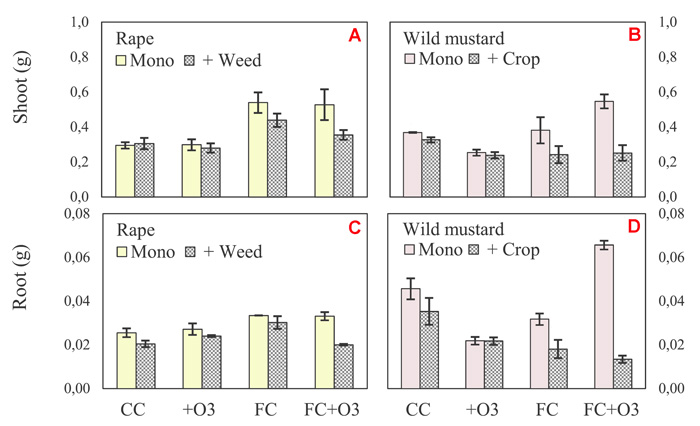| Tweet | Follow @co2science |
Paper Reviewed
Kaciene, G., Miskelyte, D., AbdElgawad, H., Beemster, G., Asard, H., Diksaityte, A., Zaltauskaite, J., Sujetoviene, G., Januskaitiene, I. and Juknys, R. 2019. O3 pollution in a future climate increases the competition between summer rape and wild mustard. Plant Physiology and Biochemistry 135: 194-205.
In a multi-factorial experiment, Kaciene et al. (2019) recently set out to examine the impact of elevated CO2, elevated temperature and elevated ozone (O3) on the growth of oilseed rape (Brassica napus), an important agricultural crop, and wild mustard (Sinapis arvensis), a weed often found in competition with B. napus, in both monoculture and mixed-culture environments.
To accomplish this objective, seedlings of the two species were grown in controlled-environment phytochambers at Vytautas Magnus University, Lithuania, under the following four treatment conditions over a period of three weeks: (1) current climate (CC), where day/night temperatures were maintained at 21/14 °C, CO2 at 400 ppm and O3 at ambient levels, (2) current climate plus ozone (+O3), which was identical to the CC treatment with the exception of O3 concentration, which was 180 µg m-3 higher, (3) future climate (FC), in which temperatures were maintained at day/night values of 25/18 °C, while CO2 was elevated to 800 ppm and O3 was maintained at ambient levels, and (4) future climate plus O3 (FC+O3), which treatment was identical to the FC treatment with the exception of an additional 180 µg m-3 of O3. The compositions of species grown in each of these four treatments included monoculture oilseed rape, monoculture wild mustard and a mixed-culture of 8 wild mustard and 16 oilseed rape seedlings.
In terms of growth, as shown in the figure below, elevated CO2 and elevated temperature increased the shoot and root biomass of oilseed rape in both mono- and mixed-culture, whereas elevated O3 had no significant impact on these parameters. In contrast, for monoculture wild mustard, shoot biomass was only slightly augmented in the FC treatment (relative to CC) and root biomass was significantly reduced. Elevated O3 had both a negative and positive effect on monoculture wild mustard shoot and root biomass (negative when comparing +O3 with CC and positive when comparing FC+O3 with FC). When grown in mixed-culture, wild mustard root and shoot biomass under the +O3, FC and FC+O3 treatments were all lower than that observed under control CC treatment conditions.
Commenting on these and other of their findings, the authors say their results "revealed that elevated CO2 and temperature stimulated rape's growth: biomass of root and shoot, leaf area as well as accumulation of soluble sugars significantly increased." The most interesting take-home message of Kacine et al.'s study, however, is gleaned from their mixed-culture experiment. Although oilseed rape biomass was reduced by weed competition from wild mustard in the FC and FC+O3 treatments, the authors report that "the competitiveness of rape increases more than that of the wild mustard" (emphasis added), indicating that this important agricultural crop will have a greater competitive advantage over wild mustard in the future. With respect to the mechanisms that underlie this positive shift in competition for rape, the authors report it consists of "better antioxidative protection, particularly elevated total antioxidative capacity and activities of peroxidase and ascorbate peroxidase."
Consequently, in light of these many findings described above, it can be expected that the growth of oilseed rape will be enhanced as temperatures warm and atmospheric CO2 concentrations rise in the future, regardless of tropospheric ozone levels, and that this important crop will become even more competitive against the invasive wild mustard weed.

Figure 1. Shoot (A, B) and root (C, D) dry biomass (with associated standard errors) of summer rape and wild mustard grown under different climate conditions (CC = current climate, +O3 = elevated O3 treatment at current climate, FC = future climate, FC + O3 = elevated O3 treatment at future climate). Source: Kaciene et al. (2019).




